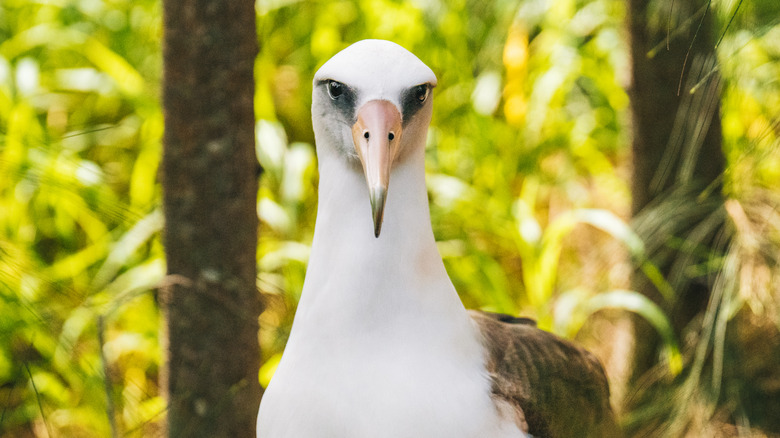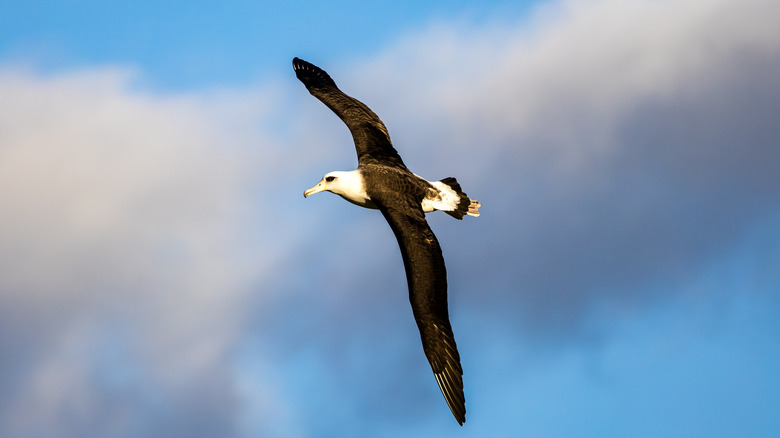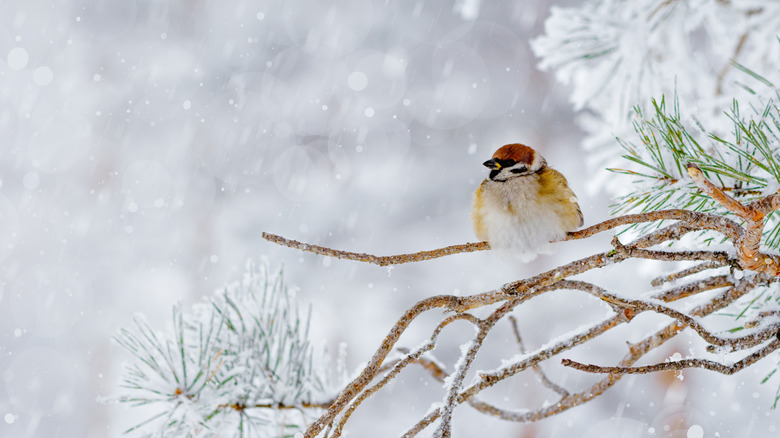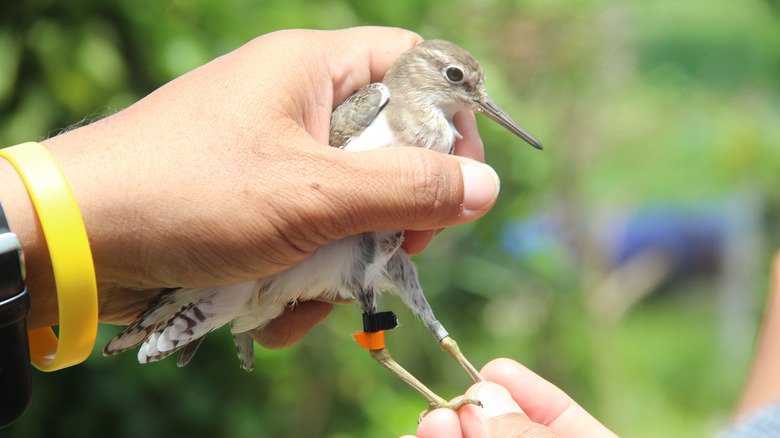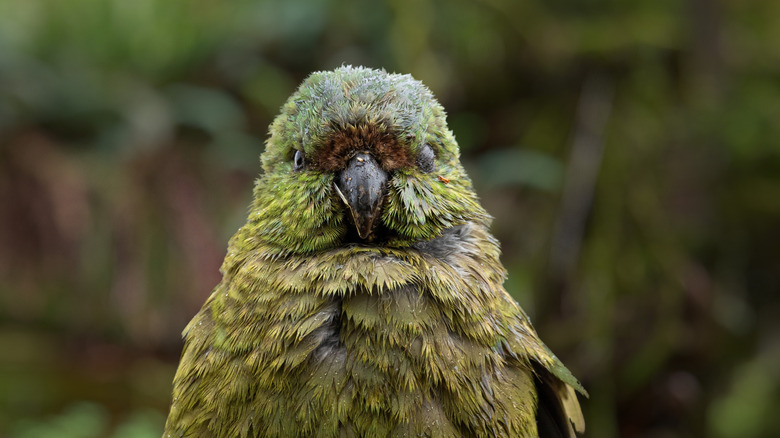Which Bird Has The Longest Lifespan? It's Complicated
Nature is full of incredible phenomena, not least in the form of animals and organisms that can vastly outlive humans. Earth's oldest living organism, for example, is an aspen tree collective on the side of a highway in Utah, and when it comes to which animals live the longest, invertebrates such as the mud clam can live at least 500 years. Then, there's Henry, the crocodile that's lived longer than most humans ever will.
But with birds, things get a little more complicated. Guinness World Records lists the oldest bird ever recorded as "Cookie," a Pink Cockatoo from Brookfield Zoo near Chicago that lived to the age of 83. However, zoo staff didn't know Cookie's age when he arrived at the zoo in 1934, and documented him as being at least one year old in May of that year, listing his "hatch date" as June 30, 1933. This gets to the nub of the issue with aging birds and estimating their lifespans — it's difficult to establish exactly when birds hatch and when they die, especially in the wild.
Which birds actually live the longest?
Identifying the bird species that lives the longest is a tricky affair. However, if you simply want to know the oldest living wild bird (that we know of), that title is currently held by Wisdom, a 74-year-old Laysan albatross. Wisdom is the world's oldest-known banded wild bird. The term "banding" refers to the process by which researchers capture birds, record information about them, attach a numbered band to their legs, and set them free. The banded birds are listed in a database and recaptured at a later date in order to track any changes.
Wisdom breeds at the Midway Atoll National Wildlife Refuge in the Pacific Ocean and was first banded all the way back in December 1956, by Chandler Robbins. At the time, she was sitting on her nest having recently laid a clutch of eggs. Due to the fact Laysan albatross don't reach sexual maturity until they are at least 6 years old, she was at least that old, if not older, when she was first banded, making her 74 years old at the minimum. Similar to Cookie, Wisdom again highlights one of the main issues with properly recording bird lifespans, in that she demonstrates how difficult it can be to get an accurate birth date for the creatures.
Birds age in a way that's different to other animals
While we have a solid understanding of bird life cycles, bird lifespans are a different story. Birds are remarkable for many reasons, not least due to the ways in which they differ from other animals. Birds share some similarities with mammals, but how they age doesn't appear to be one of them. Firstly, once birds receive their adult plumage, they don't usually show any obvious signs of aging. Although there are subtle signs, birds mostly exist in their adult form until they pass away, making it difficult to get even a rough idea of how old a bird might be based solely on their appearance.
Birds also differ from mammals in the sense that aging is typically linked to metabolic rate in the latter. While smaller mammals with faster metabolisms are expected to have shorter lifespans, the same doesn't hold for all birds. A 2016 study published in the journal Biochemistry (Moscow) remarked that most birds live two to three times longer than mammals of the same size. Prior to that, a 2001 study in Experimental Gerontology investigated birds' long lifespans and slow rate of aging relative to mammals, noting how their high metabolic rates, body temperatures, and blood glucose levels should have been indicators of reduced lifespans but were, paradoxically, not. Still, there is one similarity between birds and other animals in that the larger the bird the longer it's likely to live.
Why birds are so resilient when compared to their mammalian counterparts remains a mystery, but theories suggest it could have to do with flight, which requires a certain level of physicality that allows birds to stay healthy longer than other animals. While such comparative resilience is impressive, it makes the task of accurately recording birds' lifespans all the more difficult as researchers really can't rely on visual cues or their understanding of typical mammalian aging.
The problem with bird banding
One of the main issues with recording bird lifespans is actually keeping track of the creatures. Banding is a very helpful tool in tracking bird ages, and the main way in which researchers can keep track of wild birds' ages. But this is far from a reliable way of tracking how long the creatures live. The chances of recapturing a banded bird are actually quite low, especially when it comes to migratory birds who move to different areas throughout the year. Even with non-migratory birds, banding isn't always going to provide us with the most reliable lifespan data as many birds are first banded as adults, meaning their actual hatch date is unknown.
There's also the issue of just how birds die in the wild. It is, for example, far more common for them to die as a result of predation, issues with their habitat, or inclement weather than it is for them to pass away from old age. There are also issues such as cataracts to consider. We know that birds develop such eyesight problems in captivity, and if the same is true of wild birds, this will make them far more likely to slam into objects, adding yet another factor to the "what kills birds in the wild?" question and making it harder to get an accurate picture of how long a bird species is able to last without these extra factors in play.
We might then ask how long birds in captivity live for. But even when we know a bird's hatch date and date of death, this doesn't tell us much about wild birds' lifespans, as non-captive birds lead very different lives.
The birds with the longest lifespans (that we know of)
Despite the problems with accurately recording bird lifespans, we have a rough idea of the birds who tend to live the longest. The New Zealand parrot, or kākāpō, for instance, has been recorded as living for more than 90 years in captivity, which puts it ahead of Wisdom the Laysan albatross.
Other birds with impressive lifespans include the Arctic tern which can live for more than 30 years, and the brown pelican which has been shown to survive for almost 30 years. The bald eagle is also noteworthy for being able to last for more than 40 years in some instances. That said, these numbers are not averages but extreme examples.
There are likely several birds that have lived for longer than even these extreme examples, but we don't know about them due to the difficulties with recording exact birth and death dates for the animals. It's also worth noting that, once a bird dies, it can be difficult to find the body and record the death due to scavenging and the fact that the bodies biodegrade fairly quickly. With all that in mind, it's quite remarkable we have the limited understanding of bird lifespans that we do.
